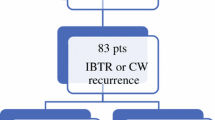Abstract
Background
Sentinel lymph node biopsy (SLNB) allows for staging of the axillary node status in early-stage breast cancer (BC) patients and avoiding complete axillary lymph node dissection (ALND) when the sentinel lymph node (SLN) is proven to be free of disease. In a previous randomized trial we compared SLNB followed by ALND (ALND arm) with SLNB followed by ALND only if the SLN presented metastasis (SLNB arm). At a mid-term of ≈ 6 years median follow-up, the two strategies appeared to ensure similar survival and locoregional control. We have revised these previous findings and update the results following a 15-year observation period.
Methods
Patients were randomly assigned to either the ALND or SLNB arm. The main endpoints were event-free survival (EFS), overall survival (OS), and axillary disease recurrence. EFS and OS were assessed using Kaplan–Meier analysis and the log-rank test.
Results
The ALND and SLNB arms included 115 and 110 patients, respectively. At 14.3 years median follow-up, 39 primary BC-related recurrences occurred, 22 (19 %) of which occurred in the ALND arm and 17 (16 %) occurred in the SLNB arm (p = 0.519). No axillary relapse developed in the SLNB arm, while two were observed in the ALND arm. OS (82.0 vs. 78.8 %) and EFS (72.8 vs. 72.9 %) were not statistically different between the ALND and SLNB arms (p = 0.502 and 0.953, respectively).
Conclusions
SLNB is a safe and efficacious component of the surgical treatment of early-stage BC patients. In the long-term, SLNB is equivalent to ALND in terms of locoregional nodal disease control and survival in this subset of patients.

Similar content being viewed by others
References
Krag DN. The sentinel node for staging breast cancer: current review. Breast Cancer 1999;6:233–6.
Peintinger F, Reitsamer R, Stranzl H, Ralph G. Comparison of quality of life and arm complains after axillary lymph node dissection vs sentinel lymph node biopsy in breast cancer patients. Br J Cancer 2003;18:648–52.
Canavese G, Catturich A, Vecchio C, et al. Sentinel node biopsy compared with complete axillary dissection for staging early breast cancer with clinically negative lymph nodes: results of a randomized trial. Ann Oncol. 2009;20:1001–7.
Veronesi U, Paganelli G, Viale G, et al. Sentinel lymph node biopsy and axillary dissection in breast cancer: results in a large series. J Natl Cancer Invest. 1999;91:368–71.
Veronesi U, Paganelli G, Viale G, et al. A randomized comparison of sentinel-node biopsy with routine axillary dissection in breast cancer. N Engl J Med. 2003;349:546–53.
Mansel RE, Fallowfield L, Kissin M, et al. Randomized multicenter trial of sentinel node biopsy versus standard axillary treatment in operable breast cancer: the ALMANACH trial. J Natl Cancer Inst. 2006;98:599–609.
Zavagno G, De Salvo GL, Scalco G, et al. A randomized clinical trial on sentinel lymph node biopsy versus axillary lymph node dissection in breast cancer: results of the Sentinella/GIVOM trial. Ann Surg. 2008;247:207–13.
Krag DN, Anderson SJ, Julian TB, et al. Sentinel-lymph-node resection compared with conventional axillary-lymph-node dissection in clinically node-negative patients with breast cancer: overall survival findings from the NSABP B-32 randomised phase 3 trial. Lancet Oncol. 2010;11:927–33.
Zavagno G, Del Bianco P, Koussis H, Artioli G, Carraro P, De Salvo GL, Mencarelli R, Belardinelli V, Marconato G, Nitti D. Clinical impact of false-negative sentinel lymph nodes in breast cancer. Eur J Surg Oncol 2008;34:620–5.
Blanchard DK, Donohue JH, Reynolds C, et al. Relapse and morbidity in patients undergoing sentinel lymph node biopsy alone or with axillary dissection for breast cancer. Arch Surg. 2003;138:482–7.
Zavagno G, Carcoforo P, Franchini Z, et al. Axillary recurrence after negative sentinel lymph node biopsy without axillary dissection: a study on 479 breast cancer patients. Eur J Surg Oncol. 2005;31:715–20.
Ogiya A, Kimura K, Nakashima E, et al. Long-term prognoses and outcomes of axillary lymph node recurrence in 2578 sentinel lymph node-negative patients for whom axillary lymph node dissection was omitted: results from a Japanese hospital. Breast Cancer. 2016;23(2):318–22.
Veronesi U, Viale G, Paganelli G, et al. Sentinel lymph node biopsy in breast cancer. Ten-year results of a randomized controlled study. Ann Surg. 2010;251:595–600.
Ashikaga T, Krag DN, Land SR, et al. Morbidity results of the NSABP B-32 trial comparing sentinel lymph node dissection versus axillary dissection. J Surg Oncol. 2010;102:111–8.
Giuliano AE, Hunt KK, Ballman KV, et al. Axillary dissection vs no axillary dissection in women with invasive breast cancer and sentinel node metastasis. A randomized clinical trial. JAMA 2011;305:569–75.
Giuliano AE, McCall L, Beitsch P, et al. Locoregional recurrence after sentinel lymph node dissection with or without axillary dissection in patients with sentinel lymph node metastases. Ann Surg. 2010;252:426–33.
Canavese G, Dozin B, Vecchio C, et al. Accuracy of sentinel lymph node biopsy after neoadjuvant chemotherapy in patients with locally advanced breast cancer and clinically positive axillary nodes. Eur J Surg Oncol. 2011;37:688–94.
Lyman GL. Appropriate role for sentinel node biopsy after neoadjuvant chemotherapy in patients with early-stage breast cancer. J Clin Oncol. 2015;33:232–4.
Zhang L, Liu C, Wang W, et al. Is optimal timing of sentinel lymph node biopsy before neoadjuvant chemotherapy in patients with breast cancer? Surg Oncol. 2012;21:252–6.
Lyman GL, Temin S, Edge SB, et al. Sentinel lymph node biopsy for patients with early-stage breast cancer: American Society of Clinical Oncology clinical practice guideline update. J Clin Oncol. 2014;32:1365–83.
Acknowledgments
The authors acknowledge the extremely valuable contribution of the ‘Registro Tumori Ligure’ for the assessment of primary tumor recurrences.
Disclosure
None.
Author information
Authors and Affiliations
Corresponding author
Electronic Supplementary Material
Below is the link to the electronic supplementary material.
Rights and permissions
About this article
Cite this article
Canavese, G., Bruzzi, P., Catturich, A. et al. Sentinel Lymph Node Biopsy Versus Axillary Dissection in Node-Negative Early-Stage Breast Cancer: 15-Year Follow-Up Update of a Randomized Clinical Trial. Ann Surg Oncol 23, 2494–2500 (2016). https://doi.org/10.1245/s10434-016-5177-4
Received:
Published:
Issue Date:
DOI: https://doi.org/10.1245/s10434-016-5177-4




